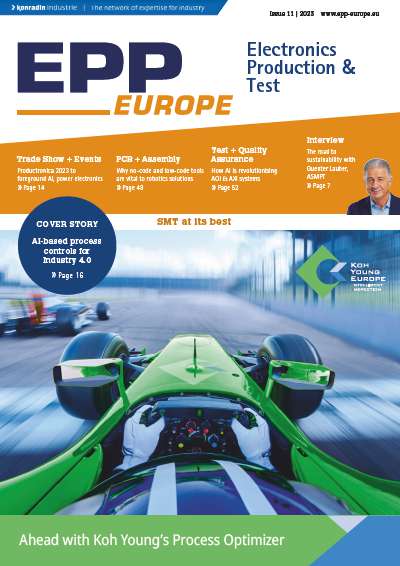Held against Munich’s monster shows Electronica or Productronica, Semicon Europa is a modest affair in terms of common business figures: just four halls of the vastly expanded fair grounds are occupied by it. This year in mid April, the trade fair attracted some 780 exhibiting companies (slightly down from 835 last year), and 11,400 visitors came (13,000 in 2001). Not too bad for an industry that has just „weathered the difficult downturn of the past year“, as Semi Europe executive Walter Roessger put it diplomatically in his welcoming remarks. Nevertheless, for this commerce it’s a key European event.
Have we really weathered the „perfect storm“ of 2001? „We had two record years“, quips Semi president Stanley Myers. „Unfortunately, one of them was a record low.“ For the worldwide chipmakers, the rupture was deep indeed: from $204bn in 2000 down to $139bn in world market volume. For the equipment vendors, the fall was equally painful: from $48 down to $28bn, a contraction by 41%. That can’t be made up in just one year. Especially not in a year like the present, where the geopolitical uncertainty pushes out all hope of a swift recovery onto a very long road to a more pleasant world economic environment.
Alright, so we have at least reached bottom (even getting there took much longer than anticipated). But how long will we have to stay there in the cold and dark? Nobody knows, or pretends not to know. Even the smart analysts and forecasters are strangely tight lipped and silent when it comes to predicting the recovery. Granted, no great impulses are to be seen, looking far and wide. The mighty investment motor of 2000, telecom equipment, is sputtering. Carriers as well as builders of IT or broadband infrastructure first will have to account for their staggering losses before they can even think of being back as buyers of equipment. Likewise mobile phones, we’ll be glad to sustain a red-zero stagnation in terms of market volume. Automotive electronics, on the other hand, although not seriously touched by the devastating storm of 2001, is still a demanding semiconductor customer – but no major market dri-ver like memo-ries and processors for data processing applications are.
Yes, orders and shipments of se-miconductors are improving, parity is near. However, they remain deeply below their 2000 peaks. Don’t expect too much of 2002, aside from a little up-tick in the second half. Real improvement will have to wait ‚til 2003. The good news: overbooking and inventory problems have finally cleared up, and much of the excess capacity is in older 0.18µm pro-cess technology. The switch to0.13 µm is in full swing, and 300mm-wafer technology is finally getting ahead as can be seen in Intel’s recent decision to get their stalled Leixlip, Ireland, waferfab back on track to open in mid-2003. That will bring the transition to 90nm wafer geometries. But one swallow doesn’t make a summer: this example is coined only to number one in semiconductor manufacturing, still operating profitable and who can afford this costly transition. It’s not becoming a mainstream at this very time.
So, the arrows in all the familiar charts are beginning to point up again since January 2002. Heroic consumer optimism in the U.S. is sustaining all of us here in Europe, too, pulling over the rough edges of the beginning millennium. Is Europe better off this time in any way? No, says Walter Roessger. „There is no market compensation by different regional economies anymore.“ All parts of the global economy are in sync. This deepens the valleys, but it might also steepen the ascent that lies ahead. What is particular for Europe is its affiliation with MEMS. This stabilizes homegrown demand. Systems integration is a large part of it, driving the modernization of Europe’s old economy industry base and, hopefully, saving it from extinction. By the way, most of the old economy business is still doing well – compared with new economy (which has survived only in some island and is dramatically struggling to earn money) and electronics manufacturing. On the other hand, MEMS are quite a disruptive technology, as Semi’s Roessger notes. „The boundaries between traditional industry segments are shifting.“
At least one good thing in the mess of the current market developments: European business in chipmaking equipment is growing at a world pace and the Old World suppliers are participating accordingly. In 2001, Europe consumed about 14% of all semiconductors, which puts it into the number-3 position. Market demand for electronic systems is healthy throughout the Old Continent. It has its stable user community, at least in the consumer, industrial electronics, control & measurement and automotive electronic industries. Eastern Europe in particular is developing its potential in systems integration and assembly with different pace depending on region – although, like in Asia Pacific and in China, not always with latest-generation technology. „We have to extend our reach into Eastern Europe,“ Semi’s Roessger maintains.
The highlight of Europe’s pride in semiconductor business: three chipmakers, STM, Infineon and Philips, are among the top-ten worldwide (see table in article on semiconductor market in this issue) now and have been for a couple of years in a row, slowly moving from the bottom to the middle and top area. Moreover, ASM Lithography claims fifth rank among the world leaders in equipment sales. „I wish we had more of these in Europe“, Roessger sighs. Right: as nice and cozy it may be in Bilthoven, Netherlands, or in Southern Bavaria, it’s certainly no Shanghai. But this is another story. And not to be forgotten: we have some smaller equipment suppliers here in Europe who have raised their colors with success (more or less, suffering from recession too). So take for example Suss Microtech, SZ Test-systems, Datacon, F&K Delvotec, Alphasem, Hesse & Knips, M+W Zander, Multi-test, Mühlbauer, Schiller, Steag-Hamatech and some others. In comparison to a decade before, this is really an encouraging outlook for a higher international presence of European-based equipment companies in the mid and long-term. Even if it’s still a long way for some of them.
Next waystation to recovery is Semicon West in San Jose and San Francisco – July 17 to 19. By then, we will know a bit more about how we luck out in the rest of 2002. Semicon Europa will return to Munich April 1 to 3, in 2003 – hopefully leading us all into a swinging year of semiconductor activities.
Werner Schulz/gbw
Share:










